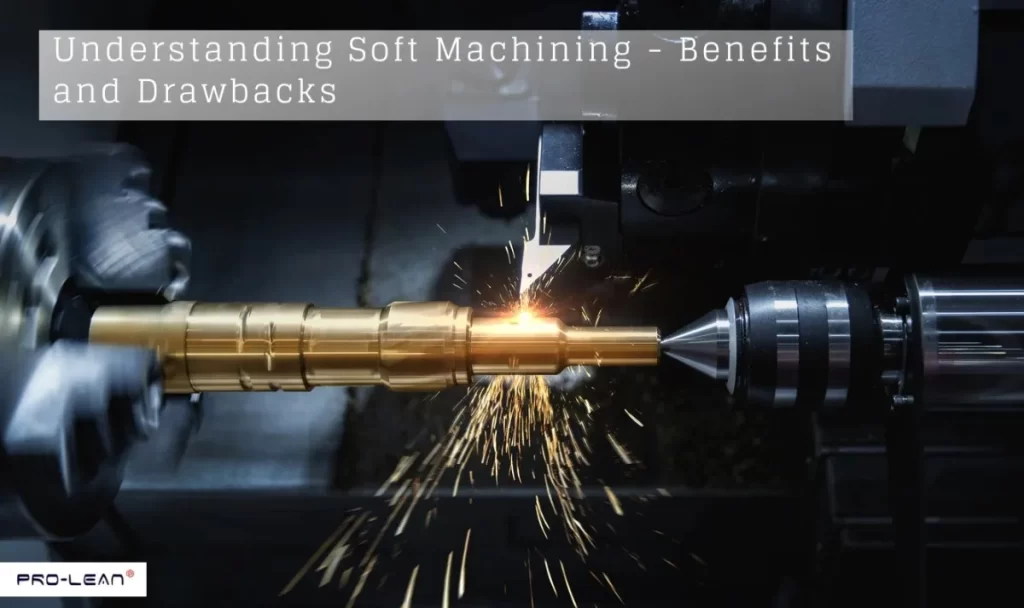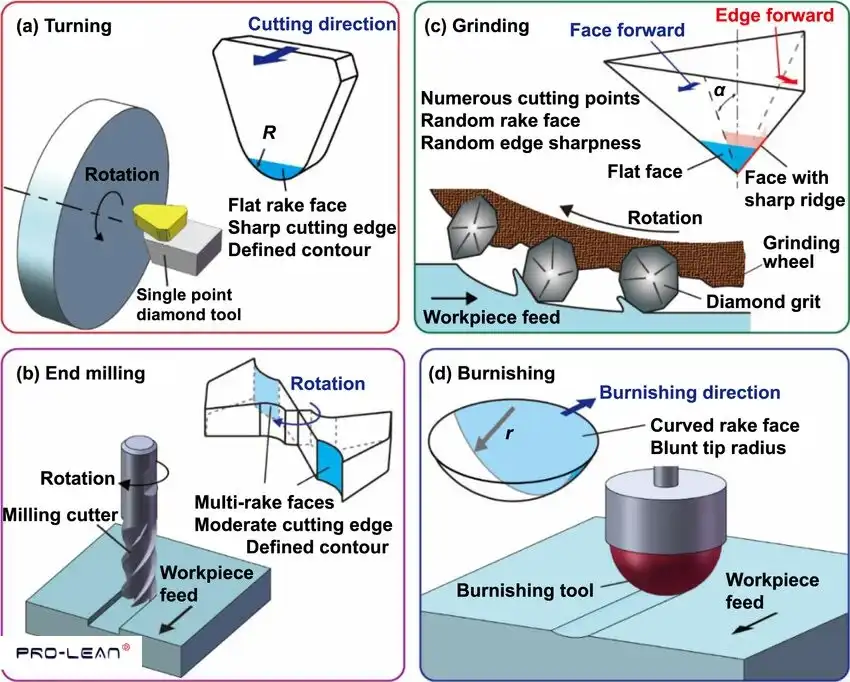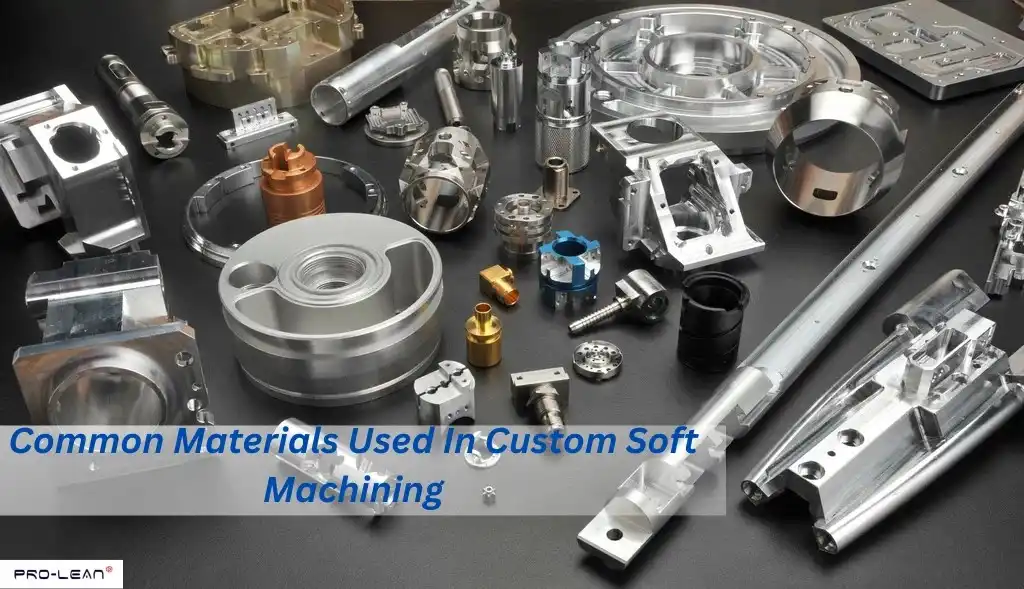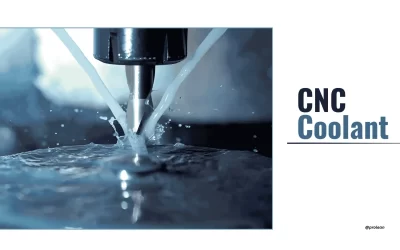
Soft Machining
Machining is the process of transforming raw materials into precise, customized products with specific sizes, shapes, and surface finishes. Among the many types of machining operations, soft machining stands out as the go-to method for working with soft metals and materials.
To achieve the best results, it’s essential to understand soft machining as a material removal technique used to shape and refine soft materials with precision.
At ProleanTech, we offer top-notch CNC machining services designed to deliver highly accurate metal parts for a variety of industries, helping businesses create efficient, high-quality products.
In this blog, we’ll take a deep dive into the world of soft machining, exploring its advantages and commonly used procedures. Stick around to learn more!
What is Soft Machining?

Defining Soft Machining Process
Soft machining is a form of machining that uses low cutting forces to remove extra material from ductile and soft raw materials. Since this machining process uses less force, pressure, and temperature, it works well for treating fragile materials and prototype items.
It is ideal for cutting soft and ductile materials, including soft metals, composites, plastics, and elastomers. Soft machining reduces thermal damage and tool wear compared to hard machining and is ideal for low volume manufacturing. Since soft materials are easily machined, machinists do not need to apply heat treatments.
Here is a comparison of soft machining and hard machining:
| Aspect | Soft Machining | Hard Machining |
| Materials | Soft metals, plastics, composites. | Hard metals like steel, titanium. |
| Cutting Forces | Low, minimal material stress. | High, handles tough materials. |
| Tool Wear | Minimal due to low resistance. | Significant, requires tougher tools. |
| Thermal Damage | Minimal, ideal for heat-sensitive items. | Higher, needs cooling systems. |
| Applications | Prototyping, soft material parts. | Durable, hard material components. |
| Cost | Low operating cost, energy-efficient. | Higher cost due to tool and energy needs. |
Try Prolean Now!
Standard Methods Used For Soft Machining

Soft Machining Standard Methods
There are different methods for soft machining, like grinding and milling. Here are the standard methods used for making complex geometries with soft machining:
1. Milling
In soft machining, milling is a flexible, low-speed cutting technique for complex designs. It removes extra material from the workpiece using a cutter with several cutting edges. Materials with precise tolerances and desired shapes often undergo this process.
2. Drilling
In this CNC machining process, drill presses are used to create holes in the workpiece with the highest level of precision and control. These presses can be attached to a milling machine.
3. Turning
Turning is the process of continually rotating a metal piece. At the same time, it engages a fixed cutting tool in a linear direction while applying a relatively small amount of force to shape it into the desired shape. Machinists use both manual and automatic turning to turn the prototypes.
4. Grinding
In order to create the final shape of the product, this procedure uses abrasion to remove extra material from raw materials. In soft machining operations, it offers extremely fine finishes and precise tolerances.
Common Materials Used In Custom Soft Machining

Soft Machining Materials
As the name indicates, soft machining is viable for soft metals and plastics to make the final product with precision. Here are the materials that can undergo soft machining:
| Material | Benefits |
| Aluminum | Lightweight, easy to machine, excellent corrosion resistance. |
| Brass | High machinability, good electrical and thermal conductivity. |
| Plastics | Lightweight, versatile, and ideal for prototyping and insulating components. |
| Copper | Excellent thermal and electrical conductivity, easy to shape. |
| Wood | Easy to cut and shape, commonly used for models and non-metal projects. |
| Foams | Lightweight and easy to sculpt, it is ideal for rapid prototyping. |
| Soft Alloys | It has low resistance and is suitable for intricate designs and precision parts. |
Try Prolean Now!
Applications of Soft Machining

Soft Machining Applications
Soft machining has applications in many industries, from medical to automotive and aerospace. Here are the applications of soft machining:
1. Medical Industry
Soft machining has applications in the medical industry. Producers of CNC medical instruments and parts use soft machining due to its tight tolerance, high accuracy, and flexibility.
It facilitates the quick prototyping of medical devices and parts and the manufacturing of orthopedic implants for hip and knee replacement. More specifically, soft machining in the medical industry makes producing endoscopic and surgical instruments and parts for diagnostic devices possible.
Related: Precision CNC Medical Machining
2. Aerospace Industry
In aerospace, soft machining offers performance and accuracy in harsh settings. It makes manufacturing wing ribs, fuselage pieces, and cabin components possible. Besides this, producing actuators, engine housings, motion control sensors, filter bodies, landing gear components, and discs has become easier.
At ProleanTech, we offer custom aerospace parts manufacturing to deliver high-precision components that meet industry standards, ensuring reliability, performance, and safety in even the most demanding applications.
3. Electronic Industry
Soft machining has many advantages for the electronics industry. It is perfect for employing CNC routers and CNC custom machining techniques to machine the casing of various electrical components. Additionally, soft machining makes it easier to produce CNC-machined semiconductor devices.
4. Automotive Industry
Soft machining is crucial in creating lightweight components such as dashboards, engine covers, and interior panels. It removes surface roughness and supports the prototyping and manufacturing of plastic and aluminum components for improved vehicle performance and efficiency.
5. Consumer Goods
Soft machining is used to produce plastic and composite parts for appliances, tools, and consumer products. It ensures high-quality finishes and precision for aesthetically pleasing designs.
6. Energy Industry
The energy sector benefits from soft machining in the production of turbine blades, generator parts, and lightweight composite materials for renewable energy equipment.
Now that we know what soft machining is and its types and applications scroll down to learn its benefits and challenges.
Benefits and Drawbacks of Soft Machining in Industries
Here are the benefits and challenges of opting for soft machining:
| Aspect | Benefits | Drawbacks |
| Precision | High accuracy and detail preservation. | Limited for hard materials or complex geometries. |
| Material Suitability | Ideal for soft materials like aluminum and plastics. | Ineffective for hard or tough materials. |
| Tool Wear | Reduced tool wear due to low resistance. | Frequent tool changes may be needed for some materials. |
| Cost Efficiency | Lower operating costs and energy use. | High initial setup costs. |
| Speed | Faster machining of soft materials. | Overheating risk for heat-sensitive materials. |
| Surface Finish | Excellent finishes with minimal post-processing. | Potential for burrs if not optimized. |
| Flexibility | Adapts to varied shapes, great for prototypes. | Not suitable for high-strength applications. |
| Environmental Impact | Less noise and vibration, eco-friendly. | Challenges in managing material waste. |
Wrap Up
That’s all you need to know about soft machining. The process is useful for soft metals and is cost-efficient. Therefore, it has applications in industries like medical, aerospace, and everyday life.
At ProleanTech, we offer all types of soft machining, including milling, drilling, and grinding, to cater a range of industries. The best part is that we imply with ISO standards for consistent quality.
Contact ProleanTech for custom CNC Machining Service.
FAQs
Q1. What is soft machining?
Soft machining is a process used to shape metals before they become hard. It’s done when the metal is still soft and easy to cut. This makes the job quicker and easier.
Q2. What is the difference between hard machining and soft machining?
Soft machining is done before a metal becomes hard. Hard machining happens after the metal is hardened. Soft machining is easier and faster, whereas hard machining needs stronger tools. Soft machining puts less stress. Both are useful, but the timing and tools are different.
Q3. What is the difference between hard metal and soft metal?
Hard metals are strong and also tough. They are used in heavy machines and tools. In contrast, Soft metals are lighter and also easier to shape. They’re used in wires, foils, and light tools. Hard metals don’t bend easily. Soft metals are more flexible. Both have different uses. The key difference is in how strong and tough the metal is.




0 Comments